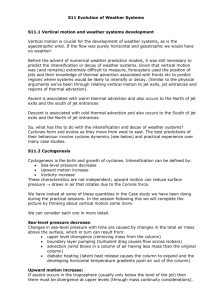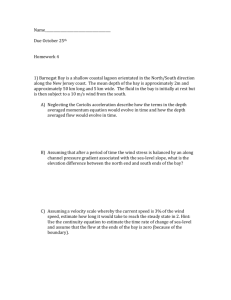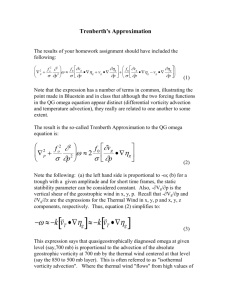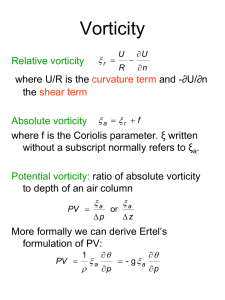SAN FRANCISCO STATE UNIVERSITY Meteorology 403
advertisement
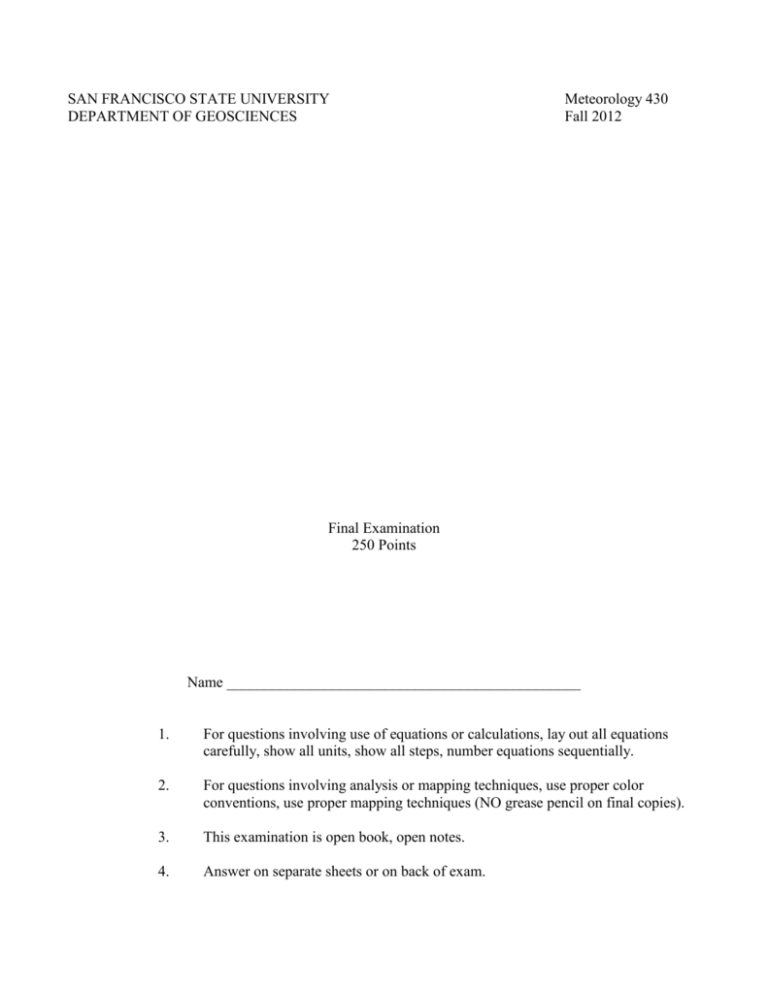
SAN FRANCISCO STATE UNIVERSITY DEPARTMENT OF GEOSCIENCES Meteorology 430 Fall 2012 Final Examination 250 Points Name _______________________________________________ 1. For questions involving use of equations or calculations, lay out all equations carefully, show all units, show all steps, number equations sequentially. 2. For questions involving analysis or mapping techniques, use proper color conventions, use proper mapping techniques (NO grease pencil on final copies). 3. This examination is open book, open notes. 4. Answer on separate sheets or on back of exam. Part A. Dines’ Compensation (95 pts) Please refer to the charts in Map Set A. 1, Attached find the WXP analyses of 200 mb and 1000 mb convergence and 500 mb vertical velocities (in x, y, p coordinates) forecast by the NAM 12Z 21 October 2010. Note the location indicated by the square off the California coast. The simplified continuity equation is DIVh = - ¶w ¶z (1) Assuming Dines Compensation, compute the vertical velocity at 500 mb that would be associated with the divergence at 200 mb. (70 pts) You will note the following: (a) (b) (c) (d) (e) the 200 mb is near the tropopause and the divergence at the point at that level is 1.0 X 10-5 s-1; 200 mb divergence is representative of the net divergence in the layer from the Level of Nondivergence (LND) to the tropopause; the vertical velocity at the tropopause is zero; the tropopause is at the 200 mb level (11880 m) and the LND is at the 500 mb level (5700 m). the 1000 mb divergence at the same point is -4.25 X 10-5 s-1 (Note: it is not necessary to know this to answer this question, but it will help you in forming your answer for (2) below. Show all work and lay out all steps. 2. Briefly explain to what extent the charts given in Map Set A GENERALLY illustrate the principle of Dines Compensation (at the location where the small box is drawn). (25 pts) 2 Part B. Surface Frontal and Isobar Analysis (80 points) Please refer to the charts in Map Set B. 1. The first chart included in the group of charts labeled “Part B Charts” is a print of sfcwxall showing surface observations in the eastern Pacific, and nam_maps nam_thick for 12 UTC 12/11/06. First, draw advection arrows and do a frontal analysis on nam_thick. (10 points) 3 2. Using your results in 1 above (the last question above) do a surface synoptic analysis on the unanalyzed chart IN THE DASHED BOX. The analysis will be graded for meteorological accuracy, AND neatness proper color and analysis conventions . Use the other charts provided (and any other map or chart included in this exam) for insight. Also, although you will not be contouring 4 outside the dashed box, you should use the observations (that are readable) outside the box to help you (70 points) 5 Part C. Relation of Upper Air to Surface Patterns (75 points) Please refer to the charts in Map Set C. 1. The simplified vorticity equation in natural coordinates is ¶z a ¶t ( +V ¶z a ) ¶ s = -z a ( Ñ·VH ) (2) a. Name and describe each term in equation (2). Then identify the term that can be dropped from equation (2) when applying it to the synoptic scale vorticity and divergence fields in the upper troposphere? (20 points) ¶z a ¶ t is the local change in absolute vorticity. It represents the change in absolute vorticity measured at a fixed location. ( +V ¶z a ) ¶ s is the absolute vorticity advection term. It measures contribution to the local change in absolute vorticity made by air parcels simply carrying their absolute vorticity from place to place. -z a ( Ñ ·VH ) is the divergence (or convergence) term. It measures the contribution to the local change in absolute vorticity made by horizontal divergence or convergence. 6 In regions in which air is flowing from higher (more positive) to lower (more negative) absolute vorticity values, the vorticity advection is termed positive (or cyclonic). In regions in which air is flowing from lower (more negative) to higher (more positive) absolute vorticity values, the vorticity avection is termed negative (or anticyclonic). Horizontal divergence is positive and negative horizontal divergence is horizontal convergence. b. Briefly explain the justification for the simplification you made in (a). (15 pts) In the upper troposphere, the vertical advection of absolute vorticity is zero, since there is no vertical motion or it is negligible, in the upper troposphere. This term can be dropped from Equation (1). The local change in absolute vorticity is very small since it is dominated by the other terms. Thus, the local change also can be dropped from the equation on an order of magnitude basis. This leaves the remaining terms (a) absolute vorticity advection; (b) and the horizontal divergence term. The resulting equation states that vorticity advection patterns can be used to diagnose or deduce divergence patterns in the upper troposphere. The resulting equation is: c. In the group of charts labeled “Part B Charts,” you will find the 300 mb absolute vorticity advection, 500 mb vertical velocity and surface pressure tendency contour plots for 1200 UTC 12/11/06. Does the pattern at A correspond to what you would expect from (i) Dines Compenasation; and (ii) the pressure tendency equation , assuming that the sign of 300 mb divergence field is an estimate of the net divergence over the region? Explain. (40 points) Dines Compensation states that upper tropospheric divergence should be compensated by midtropospheric upwards motion, and compensating surface convergence. A version of Dine's Compensation is the pressure tendency equation which states that surface pressure change is the result of the net divergence out of the air column extending from the surface to the top of the troposphere. If one assumes that the sign of the net divergence is just the divergence at 300 mb, since upper tropospheric divergence nearly always exceeds the compensating lower level convergence, then one should expect surface pressure falls at A. Also, since upper tropospheric divergence almost always exceeds lower level convergence, the pressure tendency equation states that upper divergence, upward motion in the mid troposphere and surface pressure falls should be colocated. For the case shown here, upper tropospheric divergence (and surface pressure falls) should be associated with rising motion at the level of non-divergence at location A. That is verified by the analyses. 7 Finally, the simplified barotropic vorticity equation states that in the upper troposphere the horizontal divergence can be estimated by the vorticity advection. Thus, surface pressure falls and mid tropospheric vorticity advection should be associated (directly underneath, more or less) upper tropospheric cyclonic or positive vorticity advection. That also was the case here. 8 Part A Charts 10 11 12 Part B Charts Charts For 1200 UTC December 11, 2006 13 14 15 16 17 Part C Charts 18 19 20 21 22



